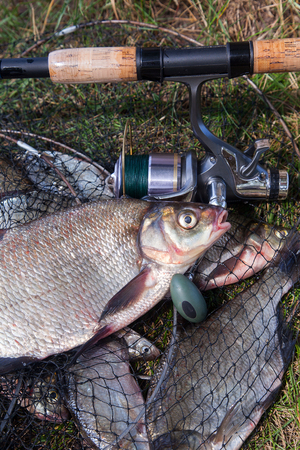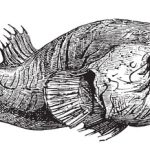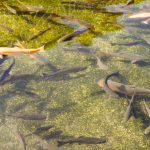1. Understanding Tuna Species Along U.S. Waters
When it comes to trolling for tuna along the American coasts, knowing your target species is key to having a successful day offshore. The U.S. waters are home to several highly sought-after tuna species, each with unique characteristics, seasonal patterns, and preferred habitats. Let’s break down the three main types: yellowfin, bluefin, and albacore.
Yellowfin Tuna (Thunnus albacares)
Also known as “ahi” in Hawaiian waters, yellowfin tuna are popular targets for anglers due to their speed, fight, and delicious meat. They’re most commonly found in warmer waters along the Gulf of Mexico, off Southern California, and around Hawaii.
Key Facts:
| Feature | Details |
|---|---|
| Peak Season | Late spring through early fall |
| Habitat | Warm offshore waters, often near temperature breaks or floating debris |
| Size Range | 30–200 lbs |
| Main Regions | Gulf of Mexico, Southern California, Hawaii |
Bluefin Tuna (Thunnus thynnus)
The heavyweight champion of American waters, bluefin tuna are prized for their size and power. These fish can grow to over 1,000 pounds and are particularly valued in sushi markets around the world. Bluefin are found mainly off the Northeast coast and the Pacific coast near California.
Key Facts:
| Feature | Details |
|---|---|
| Peak Season | June through October (Atlantic), July through December (Pacific) |
| Habitat | Cold, deep offshore waters; often near canyons or continental shelf edges |
| Size Range | 100–1,000+ lbs |
| Main Regions | Northeast Atlantic (Massachusetts to North Carolina), Pacific Coast (California) |
Albacore Tuna (Thunnus alalunga)
A favorite among light-tackle enthusiasts, albacore tuna—often called “longfin”—are smaller than other tunas but still offer a fun fight and great eating quality. They’re most commonly found off the West Coast during late summer into fall.
Key Facts:
| Feature | Details |
|---|---|
| Peak Season | July through October |
| Habitat | Cooler offshore currents, especially between 58°F–64°F water temps |
| Size Range | 10–40 lbs |
| Main Regions | Northern California to Washington State offshore waters |
Tuna Species Summary Table
| Tuna Species | Main U.S. Regions | Peak Season | Typical Size Range |
|---|---|---|---|
| Yellowfin Tuna | Southeast Coast, Gulf of Mexico, Hawaii, Southern California | Late Spring – Early Fall | 30–200 lbs |
| Bluefin Tuna | Northeast Atlantic & Pacific Coasts (CA) | Summer – Late Fall (varies by region) | 100–1,000+ lbs |
| Albacore Tuna | Northern California to Washington State offshore zones | Mid Summer – Early Fall | 10–40 lbs |
No matter which coast you’re fishing from—East, West, or Gulf—the U.S. offers world-class opportunities for trolling tuna offshore. Each species brings its own thrill and challenge to the game. Knowing when and where they show up can make all the difference on your next trip.
2. Essential Gear and Tackle for Tuna Trolling
Tuna trolling off the American coasts is all about being prepared with the right gear. Whether you’re targeting yellowfin off the East Coast or bluefin in the Pacific, having a solid setup makes all the difference when a big one hits. Let’s break down the must-have equipment to improve your hookup rates and maximize success on offshore tuna runs.
Heavy-Duty Rods and Reels
When it comes to trolling for tuna, strength matters. You’ll need rods and reels that can handle long fights and hard strikes from fast, powerful fish.
| Gear | Recommended Specs |
|---|---|
| Rod | 6 to 7 heavy-action trolling rod with roller guides |
| Reel | Conventional reel with a high line capacity (at least 50-80 lb class) |
Pro Tip:
Look for two-speed reels. The low gear helps winch in big tuna when they dive deep, while the high gear is great for reeling in slack quickly during fast runs.
Lines and Leaders
Your mainline and leader setup needs to be tough enough to handle abrasion and sudden bursts of speed. Here’s what most offshore anglers go with:
| Line Type | Details |
|---|---|
| Mainline | Braided line (65-100 lb test) for strength and sensitivity |
| Leader | Fluorocarbon leader (80-130 lb test) for stealth and abrasion resistance |
Rigging Tip:
Use a wind-on leader system so you can reel the fish closer to the boat without needing to hand-line. It’s safer and more efficient during gaffing.
Lures That Work
Tuna are aggressive feeders, but they’re also picky at times. Having a variety of lures ready lets you adapt to different conditions.
| Lure Type | Best Use Case |
|---|---|
| Cedar Plugs | A classic choice — simple, durable, and effective for yellowfin and albacore. |
| Feathers & Jet Heads | Great for high-speed trolling; mimics fleeing baitfish. |
| Diving Plugs | Ideal when tuna are feeding deeper; adds action below the surface. |
| Soft Plastics (Chains/Spreader Bars) | Mimic bait schools; often rigged with teasers to create commotion. |
Lure Color Tips:
- Bright colors like pink or green work well in clear water.
- Darker lures (black/purple) stand out better in low light or murky conditions.
Trolling Speed and Spread Setup
The way you present your lures can make or break your day. Tuna respond well to movement that mimics panicked baitfish, so speed and lure placement matter.
| Trolling Speed | Lure Type |
|---|---|
| 5-7 knots | Cedar plugs, soft plastics, spreader bars |
| 7-9 knots | Feathers, jet heads, diving plugs |
Trolling Spread Basics:
- Run at least four lines: two short (closer to the boat), two long (farther back).
- Add outriggers if available to widen your spread and avoid tangles.
Other Must-Have Tools on Board
- Gaffs or harpoons — essential for landing large tuna safely.
- Kite or helium balloon rigs — helpful in calm conditions when fish are skittish near boats.
- Bait cooler — keep fresh baits chilled if using live or dead bait alongside lures.

3. Hotspots for Tuna Fishing on the East and West Coasts
Whether youre chasing yellowfin, bluefin, or albacore, knowing where to troll is key to landing big tuna offshore. The U.S. coasts offer some of the best tuna grounds in the world. From the warm waters of the Gulf Stream off the East Coast to the nutrient-rich California Current out West, here are the top spots and best times to hit them.
🎣 East Coast Tuna Hotspots
Outer Banks, North Carolina
The Outer Banks are legendary for bluefin and yellowfin tuna. This area sits close to where the Labrador Current meets the Gulf Stream, creating a perfect feeding zone for tuna.
Best Time to Fish:
| Tuna Species | Peak Season |
|---|---|
| Bluefin | December – March |
| Yellowfin | May – October |
Cape Cod, Massachusetts
Cape Cod is a prime spot for giant bluefin. Anglers head offshore here in summer and early fall to troll ballyhoo and skirted lures for massive fish.
Best Time to Fish:
| Tuna Species | Peak Season |
|---|---|
| Bluefin | June – October |
🌊 West Coast Tuna Hotspots
The California Current (Southern California)
This current brings cool, nutrient-rich water down from the north, attracting baitfish and pelagic predators like yellowfin and bluefin tuna. Offshore from San Diego is one of the hottest trolling zones in the Pacific.
Best Time to Fish:
| Tuna Species | Peak Season |
|---|---|
| Yellowfin | July – October |
| Bluefin | April – November (with peak action June – September) |
| Dorado & Other Pelagics (bonus catch!) | August – October |
Northern California & Oregon Waters
This region sees strong runs of albacore tuna during summer months. Trolling feather jigs and cedar plugs 20–50 miles offshore can result in fast-paced action when schools move through.
Best Time to Fish:
| Tuna Species | Peak Season |
|---|---|
| Albacore | July – September |
Trolling Tips by Region
- Southeast & Mid-Atlantic: Focus on temperature breaks along the Gulf Stream; use skirted ballyhoo rigs.
- Northeast: Look for birds and surface bait schools; slow-troll live mackerel for giants.
- Socal Waters: Use poppers or stickbaits near foamers; troll spreader bars deeper offshore.
- PAC Northwest: Keep an eye on SST charts; run parallel to chlorophyll lines for consistent bites.
No matter which coast you’re fishing, understanding local conditions and timing your trip right can make all the difference when trolling for tuna offshore in American waters.
4. Techniques for Successful Trolling
Trolling for tuna along the American coasts—whether its off the shores of California, the Gulf of Mexico, or the Northeast—requires more than just throwing a line in the water. To boost your chances of hooking into a big yellowfin or bluefin, you’ll want to master some key trolling techniques that help you cover different depths and distances effectively. Here’s how.
Spreader Bars: Mimic a School of Baitfish
Spreader bars are a must-have in any tuna anglers arsenal. These rigs are designed to imitate a small school of baitfish, triggering predatory instincts in tuna. The bar holds multiple teasers (usually squids), while one lure is rigged with a hook, often placed slightly behind the rest to look like an easy target.
Pro Tip:
Use bright colors like pink or green on sunny days, and darker colors when it’s overcast.
Downriggers: Go Deep Where Tuna Feed
Sometimes tuna hang out deeper in the water column, especially during mid-day or when surface temps rise. That’s where downriggers come in handy. These devices let you troll lures at specific depths by attaching your line to a weighted ball via a release clip.
| Depth Range | Lure Type | Suggested Speed |
|---|---|---|
| 20-50 ft | Cedar plugs, deep-diving plugs | 5-7 knots |
| 50-100 ft | Feathers with weight, skirted ballyhoo | 4-6 knots |
Staggered Baits: Maximize Coverage
Staggering your lines at varying lengths and positions helps cover more water and increases the chances of hitting an active fish zone. Run some lines short and close to the boat (called “short corners”), others mid-range (“long riggers”), and a few way back (“shotgun” position).
Example Spread:
- Short Corners: 30–50 feet back with heavy lures
- Long Riggers: 70–100 feet back with flashy teasers
- Shotgun: 150+ feet back with natural baits like ballyhoo
Using Sonar and Temperature Breaks to Find Tuna
Your electronics are just as important as your tackle. Use sonar to locate bait balls and deep marks that indicate tuna presence. Pay close attention to temperature breaks—areas where warm and cool water meet—as these often concentrate baitfish and predators alike.
How to Read Water Temp Breaks:
- Slick Lines: Look for smooth patches between choppy waters; these usually mark temp changes.
- Baitfish Activity: Birds diving or fish jumping around temp breaks is a great sign.
- Tuna Preference: Yellowfin prefer temps between 72–78°F; Bluefin often favor cooler waters, around 60–68°F.
By combining these tactical trolling techniques—spreader bars for attraction, downriggers for depth control, staggered baits for coverage, and smart use of sonar and temp data—you can significantly increase your odds of hooking into that trophy tuna offshore.
5. Regulations, Conservation, and Ethical Angling
When it comes to trolling for tuna along the American coasts, understanding and following fishing regulations is just as important as knowing how to rig your lines or spot birds working the water. The U.S. has strict rules in place to help protect tuna populations and ensure offshore game fishing stays sustainable for generations to come.
U.S. Tuna Fishing Regulations
In the United States, tuna fishing is regulated by the National Oceanic and Atmospheric Administration (NOAA) and enforced through regional Fishery Management Councils. These rules vary depending on the species of tuna—such as Bluefin, Yellowfin, or Albacore—and the coast you’re fishing on (Atlantic vs Pacific). Always check current federal and state regulations before heading offshore.
Common Federal Tuna Fishing Rules:
| Species | Bag Limit | Size Limit | Season |
|---|---|---|---|
| Bluefin Tuna | 1-3 per vessel/day (varies) | 27″ to 73″ curved fork length | Seasonal quotas apply |
| Yellowfin Tuna | 3 per person/day | No federal size limit | Open year-round (subject to updates) |
| Albacore Tuna | No federal limit (check local) | No federal size limit | Open year-round |
Ethical Game Fishing Practices
Trolling for tuna isnt just about landing a big one—its about doing it the right way. Ethical angling means respecting both the fish and the ocean. That starts with using proper gear that minimizes injury to fish you don’t plan to keep, releasing undersized or out-of-season catches quickly and safely, and never exceeding legal catch limits.
Tips for Responsible Tuna Fishing:
- Use circle hooks: They reduce gut-hooking and increase survival rates for released fish.
- Avoid overfishing hotspots: Rotate your fishing locations so local stocks can recover.
- Tag and release: Participate in tagging programs that help scientists track tuna migration and health.
- Respect protected areas: Some marine zones are off-limits to commercial or recreational fishing—always check maps before heading out.
The Importance of Sustainability
Tuna are highly migratory fish that play a key role in marine ecosystems. But due to high demand—especially for Bluefin—many species have faced population declines. As responsible anglers, we must do our part to protect these incredible fish by following all rules and promoting sustainable practices within our communities. That way, future generations can also experience the thrill of trolling offshore waters for these powerful predators.
Remember:
Sustainable fishing isn’t just good ethics—it’s good fishing. Healthy tuna populations mean more action on the water for everyone.


